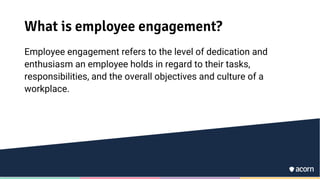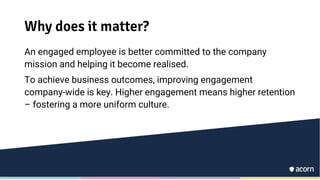Employee Engagement: How To Strengthen It
- 1. Employee Engagement How to strengthen it and why it matters.
- 2. What is employee engagement? Employee engagement refers to the level of dedication and enthusiasm an employee holds in regard to their tasks, responsibilities, and the overall objectives and culture of a workplace.
- 3. Why does it matter? An engaged employee is better committed to the company mission and helping it become realised. To achieve business outcomes, improving engagement company-wide is key. Higher engagement means higher retention – fostering a more uniform culture.
- 5. How to measure engagement The most effective methods for measuring engagement typically include some kind of survey. In order to ensure these surveys are worthwhile, several key elements need to be considered:
- 6. Define the engagement outcomes Ask questions that identify feelings, attitudes and behaviours. Engagement outcomes help provide a more holistic view of current engagement levels while identifying areas that need improvement.
- 7. Recognise what employees value Ensure the survey covers a wide range of employee engagement topics which relate to teamwork, individual recognition and career progression.
- 8. Identify a continuous listening strategy Utilise surveys at varying intervals (weekly, monthly, quarterly and annually) in conjunction with face-to-face meetings.
- 10. Why is it important? Making employee engagement part of organisational culture is crucial to strengthening and maintaining it. When executed properly, the following tips help foster engagement from the moment new hires join the organisation:
- 11. Don’t skip onboarding and training Ensure new employees are already equipped with an understanding of their role and company culture. They’re far more likely to remain engaged with their work and stay at the organisation. Set company goals It’s essential to have flexible, relevant company goals for employees to get behind and commit to.
- 12. Focus on employee development Employees need opportunities to learn and progress at each stage of their employee lifecycle. A learning management system (LMS) is an excellent way to provide self- directed development. Acknowledge employees Recognition plays a significant role in maintaining high levels of engagement as it provides an incentive to work towards.
- 13. Don’t micromanage Micromanaging impedes employee development and cultivates a space of managerial dependence where employees become unable, or unwilling, to undertake tasks in a self- directed manner. Select the right managers Select the right people for managerial roles. A good manager should be deeply engaged with their work and the overall company mission.
- 14. Coach managers, hold them accountable for engagement An engaged employee is a direct result of an engaged manager. Empower managers through training and development.
- 15. Click here to read the full article. For more resources, check out our blog.















